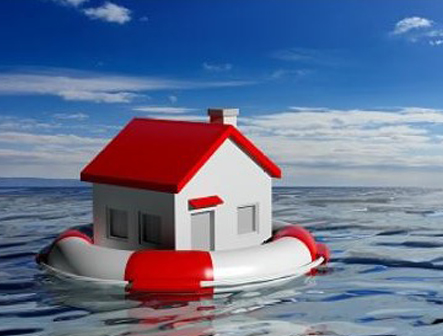
Understand the financial impacts of flood disasters
Flood damage to your home or business can be stressful and financially devastating. With adequate flood insurance coverage and your important documents organized and stored appropriately, you can recover quicker from the unforeseen disaster.
Your bank or lender may require you to purchase flood insurance if your home or business is located in a designated flood hazard area. The Federal Emergency Management Agency’s (FEMA) National Flood Insurance Program (NFIP) works with insurance companies to offer you various insurance coverage options. Coverage for a building and for the contents of a building are purchased separately. Private flood insurance coverage may be available to you outside of the NFIP.
Please note that many homeowner policies might cover water damage from broken pipes, but not flood damages from natural events or disasters, though you may choose to add flood insurance voluntarily. Contact your insurance provider regarding specific coverage information.
NFIP coverage
Residential properties
If you own a single family home, condominium, or townhouse, the NFIP offers flood insurance policies to cover your home’s structure and your belongings. When the structure of your home is insured, your home’s foundation, electrical, plumbing, finishing, and appliances are typically covered. Personal items such as, clothing, electronics, artwork, memorabilia, etc. would be covered under the contents insurance, if purchased. Coverage limits under the NFIP are $250,000 for the building and $100,000 for the contents of your home. Unless you have contents coverage, your flood-damaged belongings are not covered.
Commercial properties
If you own a commercial property, the NFIP generally allows you to obtain up to $500,000 of coverage for the building and separate $500,000 of coverage for the contents.
NFIP terms and expiration
When you purchase a NFIP policy, there is usually a 30-day waiting period before your policy goes into effect; however, there are exceptions.
For more information, visit FEMA.
NFIP flood insurance coverage has a term of one year, with the effective date stated in your policy; however, you will remain covered for 30 days after the expiration date. Within this 30-day grace period, claims for losses will be honored, but the full renewal premium must be paid by the end of the 30-day grace period. If your flood insurance premium is not paid within the grace period, you no longer have coverage.
For more information on NFIP and what it can offer you, visit National Flood Insurance Program.
Organize important documents
Keeping these items in a designated location for safekeeping is helpful when dealing with a flood disaster or emergency:
- Contact information (phone numbers and websites) for financial service providers such as your bank, brokerage firms, and insurance companies.
- Originals and copies of identification such as your driver’s license, passport, Social Security card, and birth certificate. These are helpful if you have to prove your identity. While it is best to have originals, copies are useful if the originals are lost or destroyed.
- Copies of your financial information like credit and debit cards (front and back) and checks (front). During a disaster, you may need your account information from these documents to authorize payments over the phone.
- Current insurance policy information for homeowner/renter, auto, and life insurance coverages.
- Originals and copies of medical information, such as insurance cards and health records.
- An inventory of valuable personal property (document the value of the items by keeping receipts and/or written appraisals, and perhaps photos of valuable items).
- Property ownership records such as a copy of your most recent property tax bill.
Safely store emergency records and information
- Digital storage: Most documents can be kept electronically. When deciding which documents to keep electronically, consider how to access the documents using your smartphone or a computer. Encrypt sensitive documents and set your electronic device security to require a password, your thumbprint, or facial recognition for additional safety.
- Safe deposit box at your bank: This may be an appropriate location for important documents that will be difficult or impossible to replace, and for which you do not need to access frequently. In case there’s a flood or other water damage, be sure to seal these items in waterproof plastic bags or containers.
- Waterproof emergency evacuation bag: Along with your personal safety items, you should include copies of some of the important documents listed earlier in the article (it is not advised to store your Social Security card or number in this manner in case your bag is lost or stolen) and a small amount of cash, preferably small bills as ATMs and credit cards may not work during a disaster to purchase necessary supplies. As a reminder, large amounts of cash are better off in your FDIC-insured bank account. Make sure to keep your evacuation bag in a safe and secure place in your home.
Additional resources:
Emergency Financial First Aid Kit (EFFAK)
For more consumer resources, visit FDIC.gov, or go to the FDIC Knowledge Center. You can also call the FDIC toll-free at 1-877-ASK-FDIC (1-877-275-3342). Please send your story ideas or comments to ConsumerNews@fdic.gov. You can subscribe to this and other free FDIC publications to keep informed!
